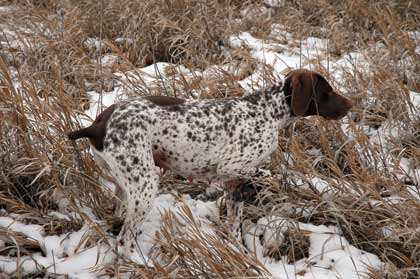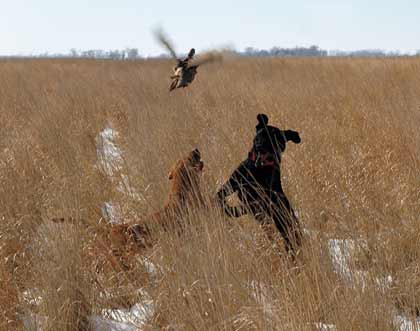One coat does not "fit all" when it comes to utility in the field or marsh.
By Chad Mason
 A liver and white coat like the one worn by this Braque Francais can blend into snowy cover a little too well. |
The color of our hunting partners is a matter of some importance. Of course I am referring to our canine partners, but the color of other kinds of partners matters as well, and I shall discuss that briefly (and carefully) before I am finished.
Whenever the subject of dog color comes up, visibility is usually the instigating factor in the conversation. Certainly, some dogs are harder to see in some kinds of terrain, and there probably is no dog that is perfectly visible in all kinds of terrain. The problem is worsened by the fact that many of us, especially among the male population, do not have acute powers of color discrimination.
As evidence of this fact, my wife will quickly point out my relative ineptitude in matching shirts to pants. Moreover, we once argued for a week about whether a certain backpack of mine was gray or "light olive, kind of a 'sagey' color." I said gray, until her side was vindicated by a panel of friends. Of course, the panel was all female.
However, there is more to this story than mere gender stereotypes; it is scientifically true that most women are optically better equipped than men to discern subtle differences in color. Chalk that up as one reason, among many, why women make excellent hunters. So maybe the color of a dog doesn't matter as much to ladies, at least from a practical hunting perspective.
But few things distract this fellow more in the field than being unable to see the dog clearly. Most people will argue that a dog with a preponderance of white in its coat is the most highly visible. This, of course, is true only if the background is not white, as it often is where I live. In the patchy snow so common in Midwestern hunting, a white-and-brown dog can be virtually invisible for much of the season.
In South Dakota one year, I lost a Brittany in plain view. He went on point 100 yards away, among scattered clumps of snow-matted cattails. He was not wearing a collar--my dogs seldom do--and I had been looking up at a passing flock of snow geese when I looked back down and suddenly sensed that the earth had swallowed my dog. I did find him eventually, and shot the wild rooster pheasant that he had pinned. The dog would have held his point until the Second Coming but it's pretty unusual for a pheasant to be that patient, even in South Dakota.
If I lived where snow was rare, I would most certainly own a white dog, and not only for practical reasons. Is there anything more beautiful than a ghostly white dog flowing across a brown hillside? (That was a rhetorical question.)
The coat colors of some breeds vary widely within the breed. German shorthairs and Small Munsterlanders especially come to mind, as well as the Braque Francais. These dogs can vary from nearly all white to heavily ticked and roan specimens. If these dogs work at some distance, as pointing dogs should, the ticked and roan dogs would be very difficult to spot against, say, an Idaho chukar mountain. In that case, white dogs would surely get the nod, until you want to hide one beside a duck pond.
 Black Labs are usually more visible in the uplands than their tawny counterparts, but the latter are easy to conceal in a variety of waterfowl hunting scenarios. |
Speaking of duck ponds, today's trend toward bleach-blonde Labrador and golden retrievers may be advantageous to pheasant hunters, but seems grossly impractical for waterfowl hunting. I once saw a picture in a magazine of a virtually white Labrador retriever in a camouflage neoprene vest. They weren't trying to be funny, but the dog looked like an albino elephant wearing a bowtie. There is nothing less conspicuous in the widest possible range of wetland (or grain field) scenarios than a tawny dog. Message to yellow Labrador and golden breeders: Give us darker coats.
Regular readers of this column will, by now, have noted that both my dogs are solid black. However, one should not conclude that I have a definite preference for black dogs. I don't. These were the dogs I wanted, and they happened to be black.
As it turns out, I've discovered many advantages in solid black dogs. Almost nothing in the outdoors is a deep, perfect, shiny black. For that reason, Rascal and Woody are highly visible to me when hunting upland birds in almost any setting, with or without snow.
The only scenario where I've found a black dog to be dangerously inconspicuous is a field of standing corn, without snow, on a bright sunny day. Under those conditions, your eyes adjust to the bright world above, and the cornrows become inky dark regions where a black dog moves through your consciousness like a barely perceptible wraith. A bright orange collar is a good idea in a cornfield, but it should be a tight-fitting elasticized model that won't snag on broken cornstalks.
When it comes time to hunt waterfowl, a black dog is easily hidden in shadows. In a goose field, the dog can actually be used to "flag" geese from a distance. Toss a white dummy for the dog and let him retrieve it when you see geese on the horizon. The motion gets their attention in a good way.
Of course, none of these advantages occurred to me before I bought black dogs. Rather, they constitute the rationalization process by which I talk myself into being even more satisfied with my dogs. I've come to justify, after the fact, the "advantages" of black.
Such justification is practiced very widely by us humans, in regard to nearly everything we acquire. But as a general rule, I think color should be far down the list of criteria for choosing a dog. Color does matter in the field, but it does not matter half as much as loving the dog you hunt with, regardless of its color.
And that brings me to other kinds of hunting partners. A bird dog magazine may seem like a strange place to talk about race relations, but we've been talking about the color of our dogs and, since dogs are almost like people to me, it's hard for me to talk about dogs and not think about people. By no means can a bird hunter deign to solve America's ongoing de facto segregation. But humbly a bird hunter can raise questions that might cause a productive kind of discomfort. And so I shall attempt to raise a few.
A quick perusal of th
is--or any other--hunting magazine will give you the impression, rightly or wrongly, that hunting in America is a quite monochromatic affair. One recent issue contains photographs of 49 persons--including advertisements--of whom 48 are white. To my own shame, conspicuously absent from my hunting album are any photos of other people who don't look pretty much like myself.
We tend to hunt with our friends, and the lack of diversity in our hunting chums may betray a broader lack of friends who are not like ourselves. We may justify this lack as a side effect of economic phenomena, but that hardly removes the uncomfortable questions it raises. Far from settling the matter, such justification only begs further questions about our society in general, and how we in particular choose our friends.
Once while hunting quail on a Southern plantation, it made me terribly uncomfortable that all the tasks of menial servitude were performed by an elderly black man, while all the white hunters lived in luxury. Without speaking much, he mixed our drinks, brought our horses, fed the dogs, cleaned our birds. His day began early and ended late.
I was startled by the persistence of this basic similarity to slavery, so long after it has been "officially" eliminated. All through the hunt I wanted to trade with him. I wanted to let him do the shooting, and I wanted to clean his birds while he put his feet up. But I didn't know how even this could be anything more than condescending patronization to assuage white guilt, and thus an act of profound selfishness. In the inescapable awkwardness I perceived that both of us were wounded in ways we could not fix.
Yet the possibility exists--through friendship. My paternal grandfather was a Kentucky coal-miner and a diehard hunter of rabbits and quail. His lifetime and his geography put him on the cusp of what is often called the "Pre-Civil Rights South." But Granddad was not well enough informed to know what prejudices were proper to his demographic, so one of his favorite hunting partners was a black man.
I have no photos of them together, because Granddad was not a picture-taking sort of man. But I can picture them in my mind, laughing and cleaning rabbits together on the dark end of day at the outer edges of a porch light. Those two men loved the same kinds of dogs, and I think they also loved each other.






